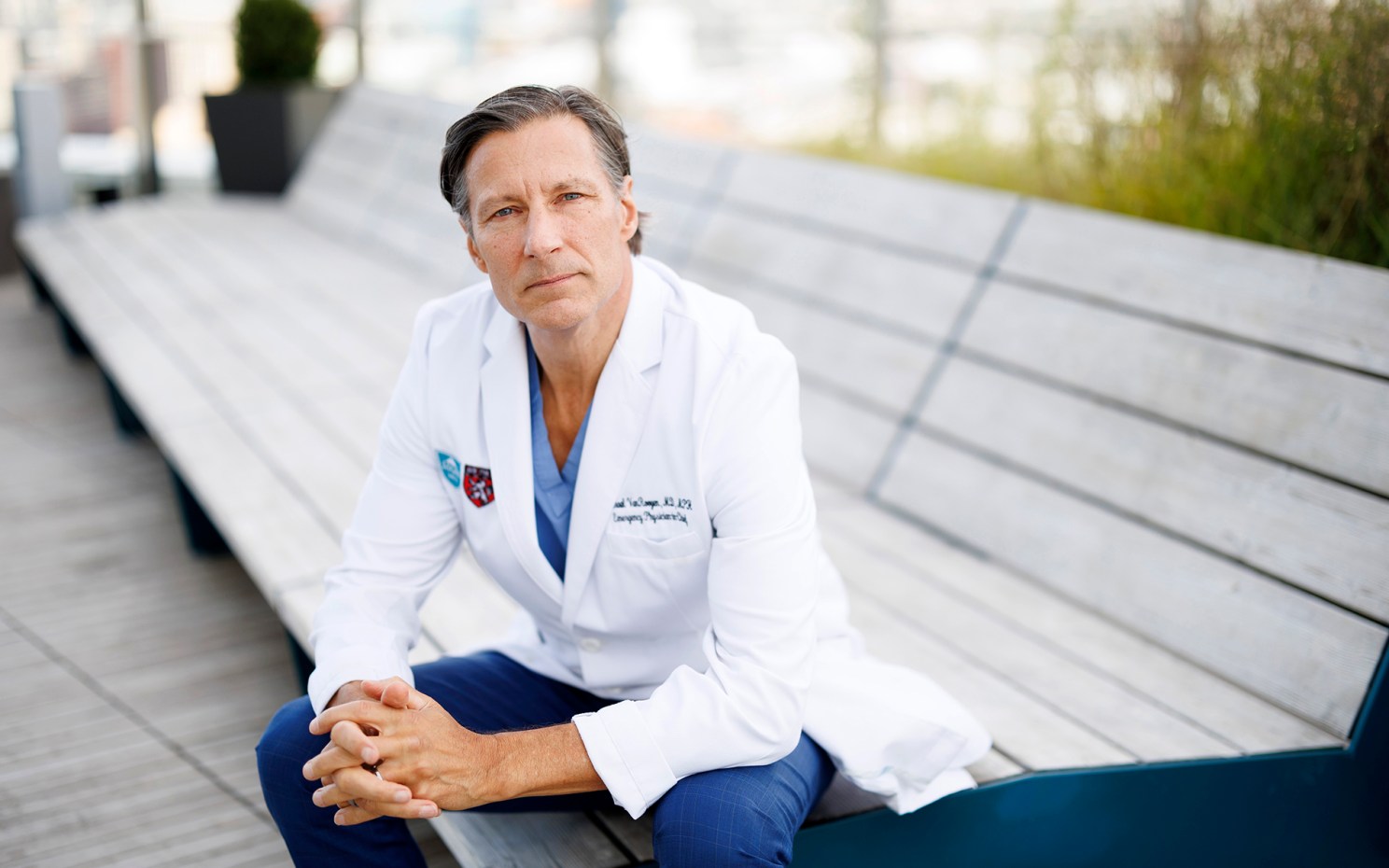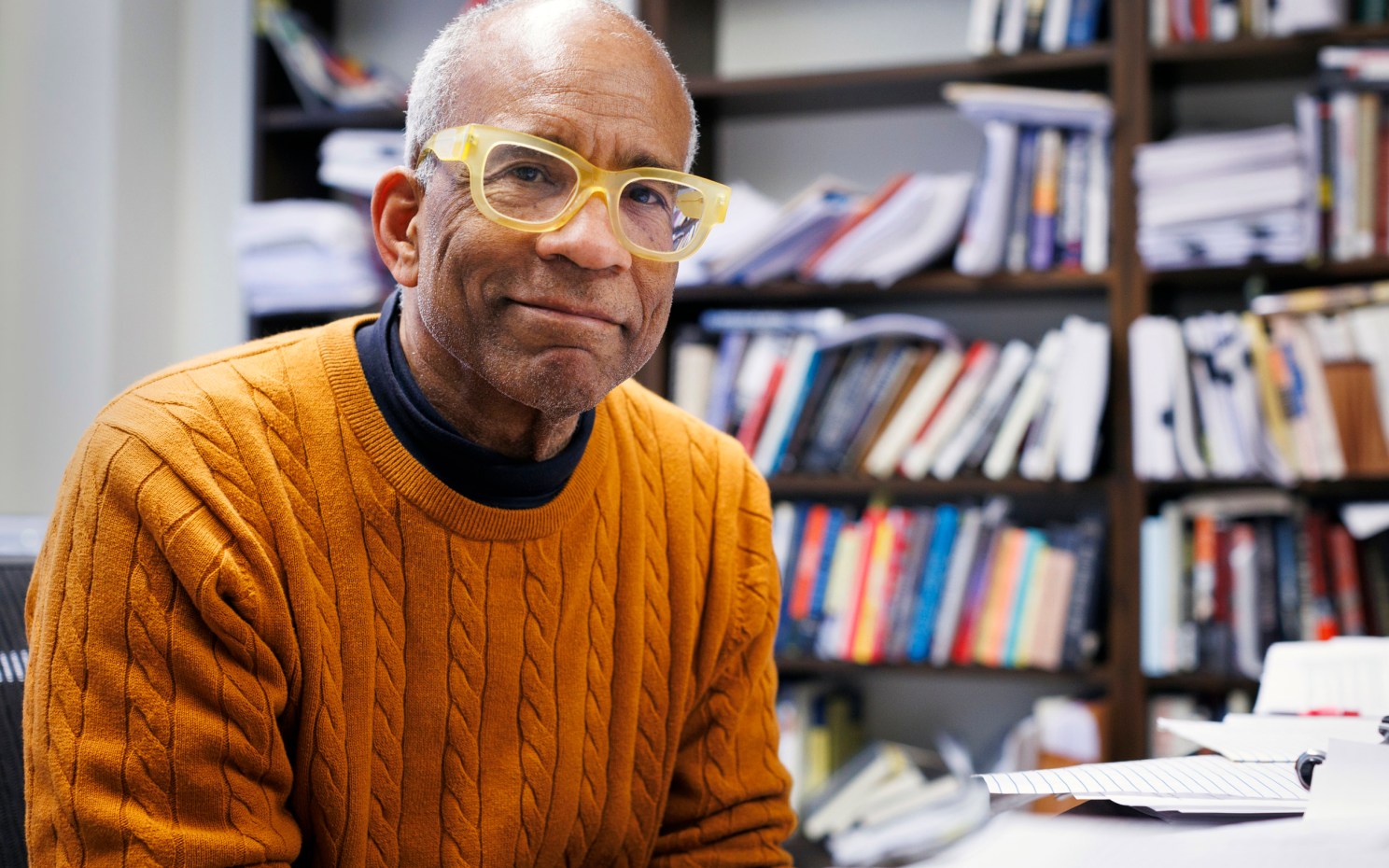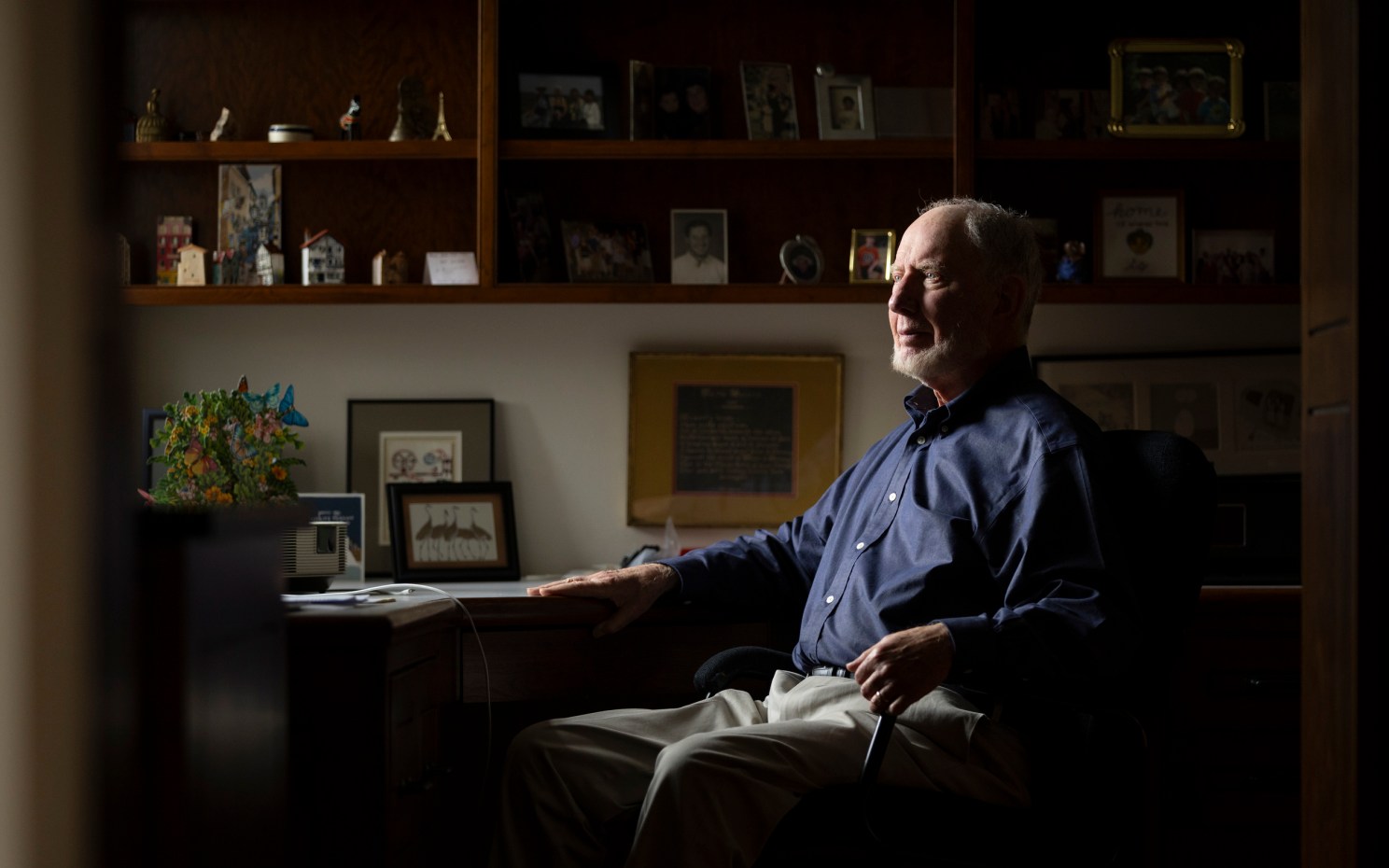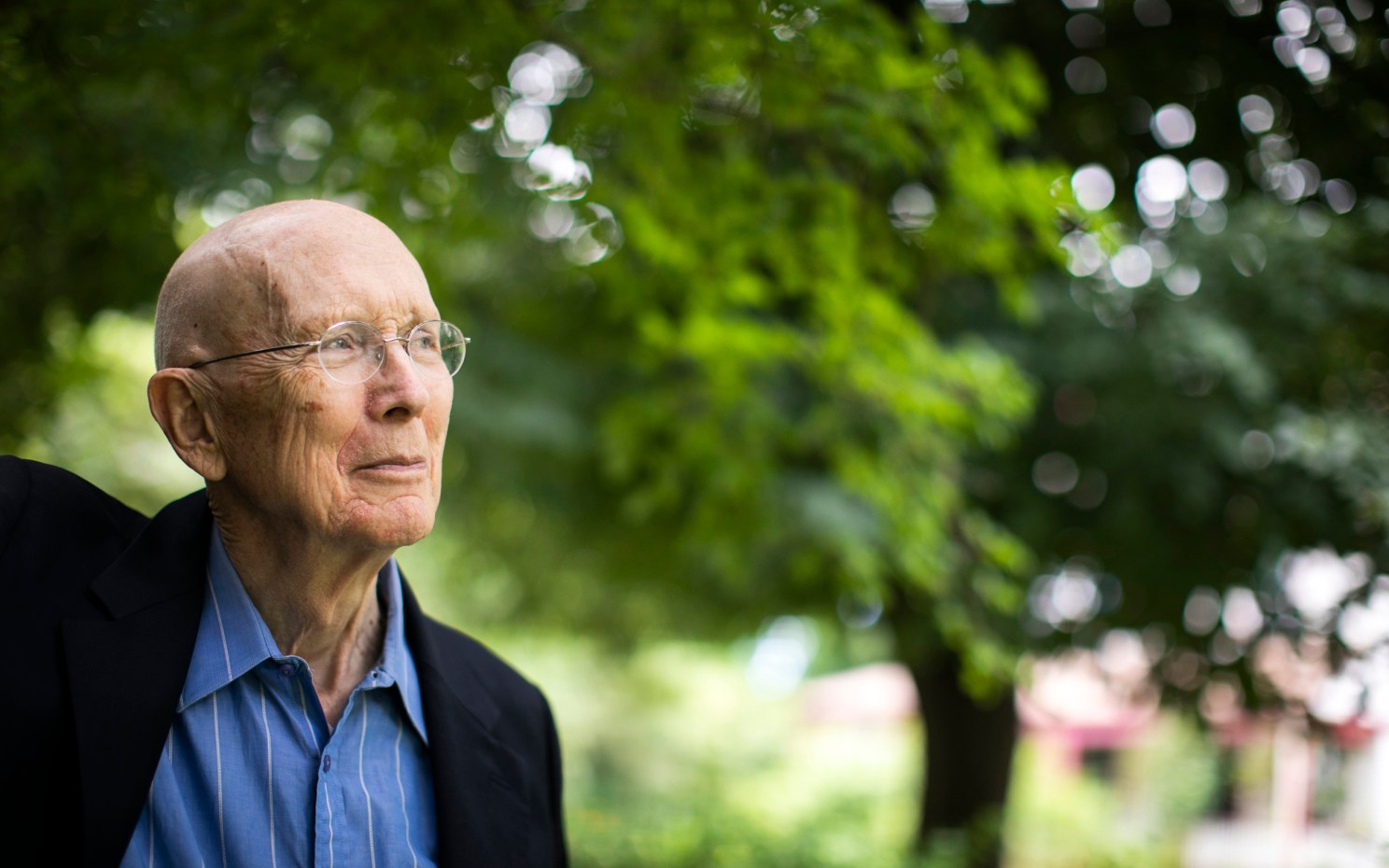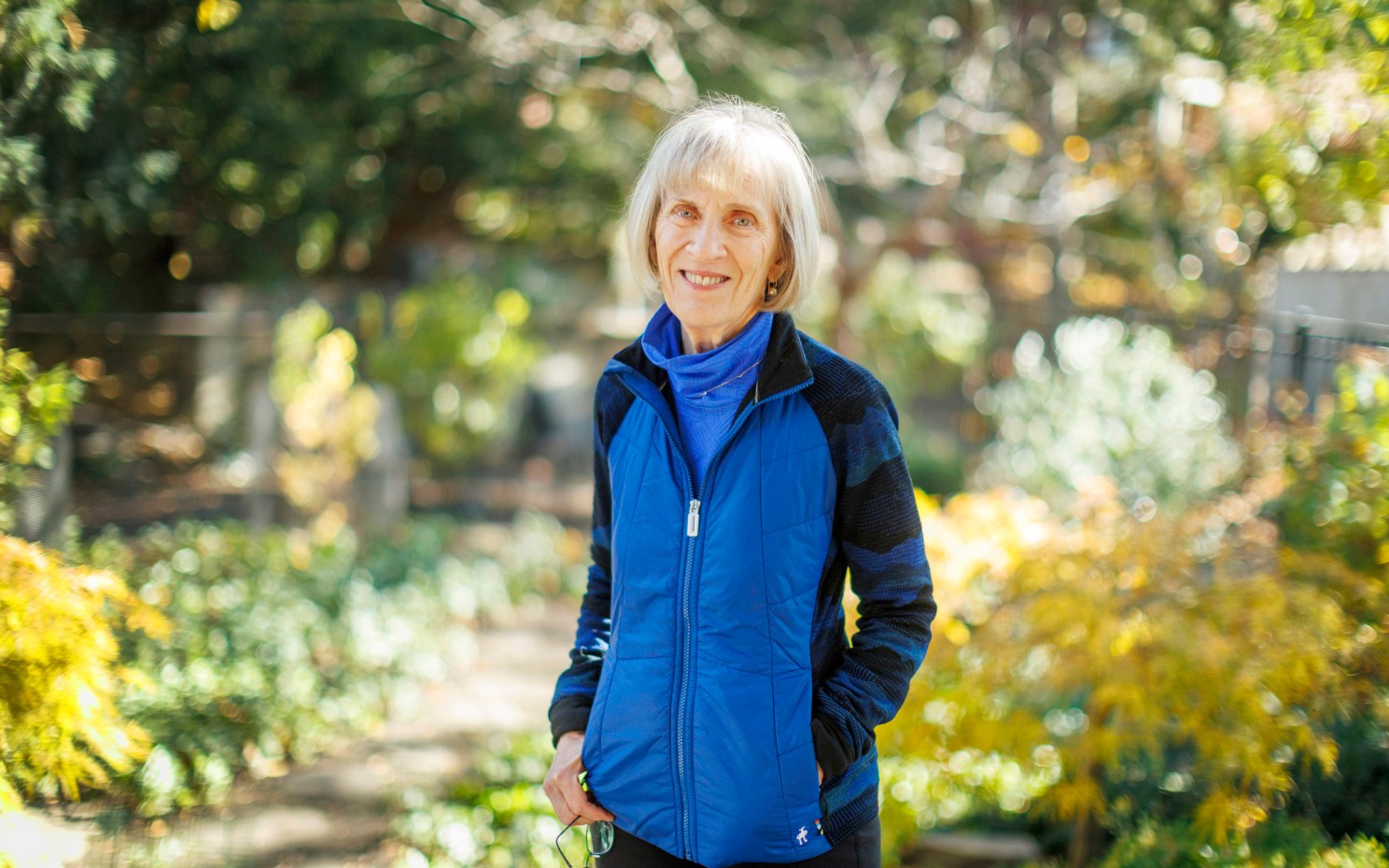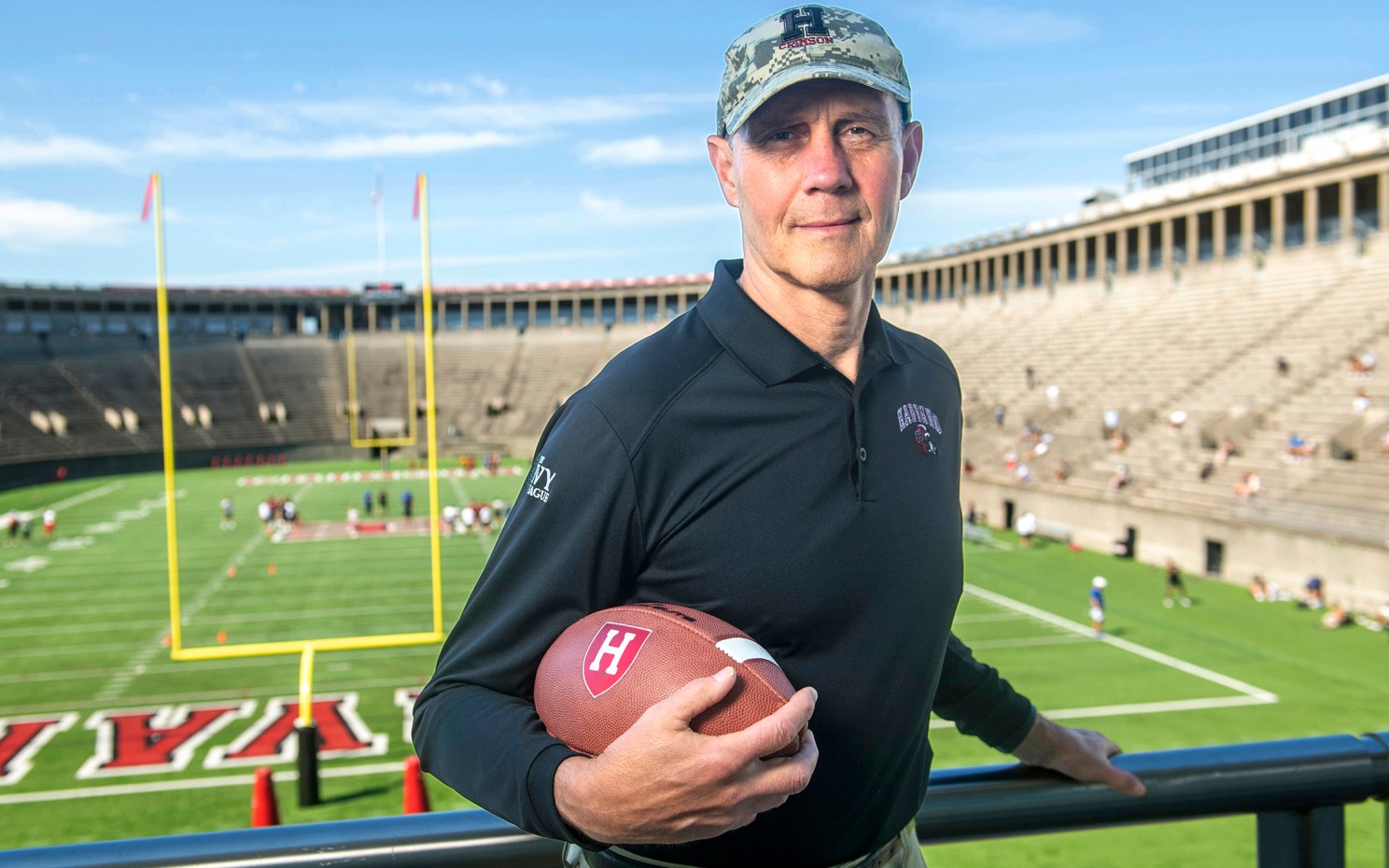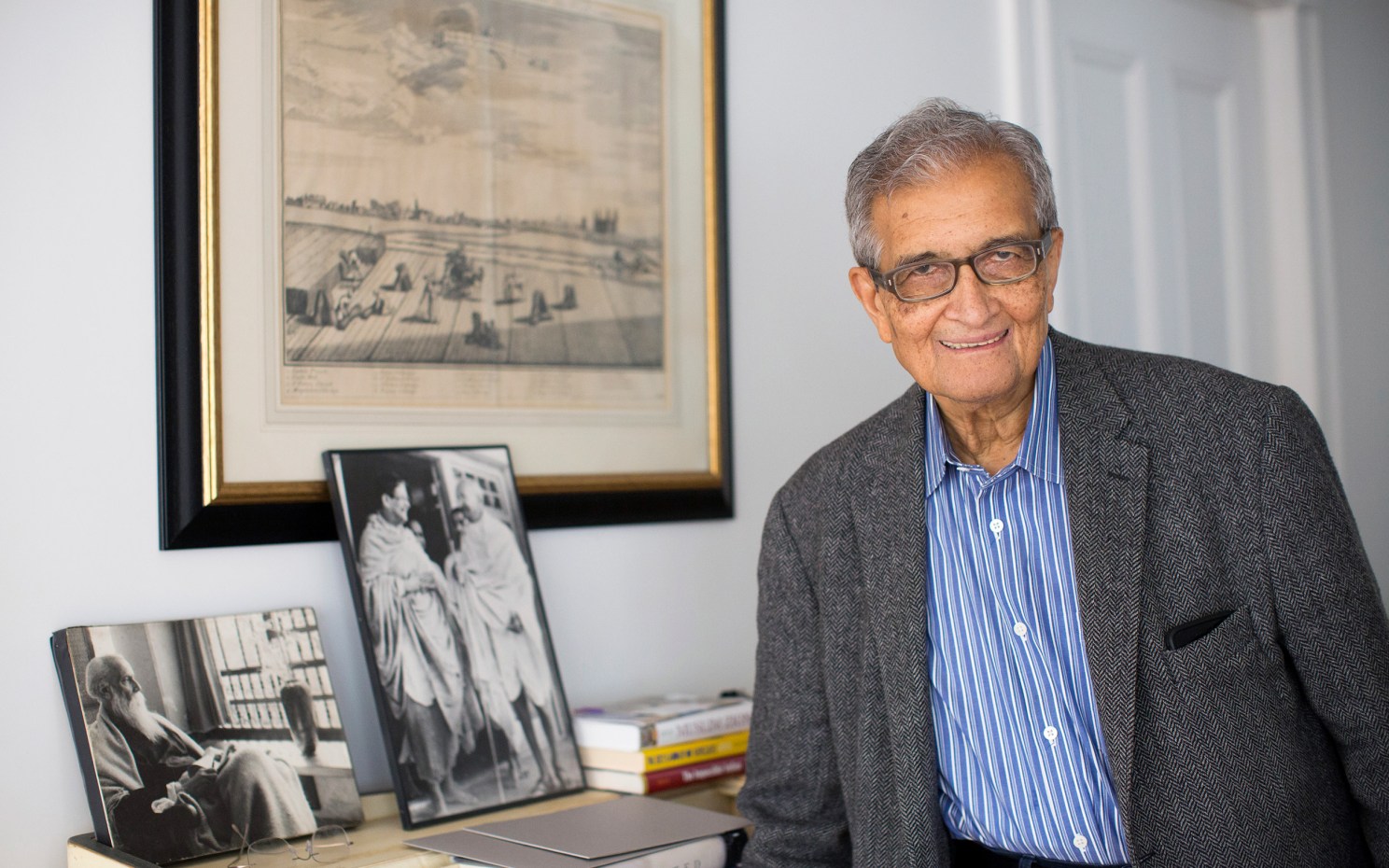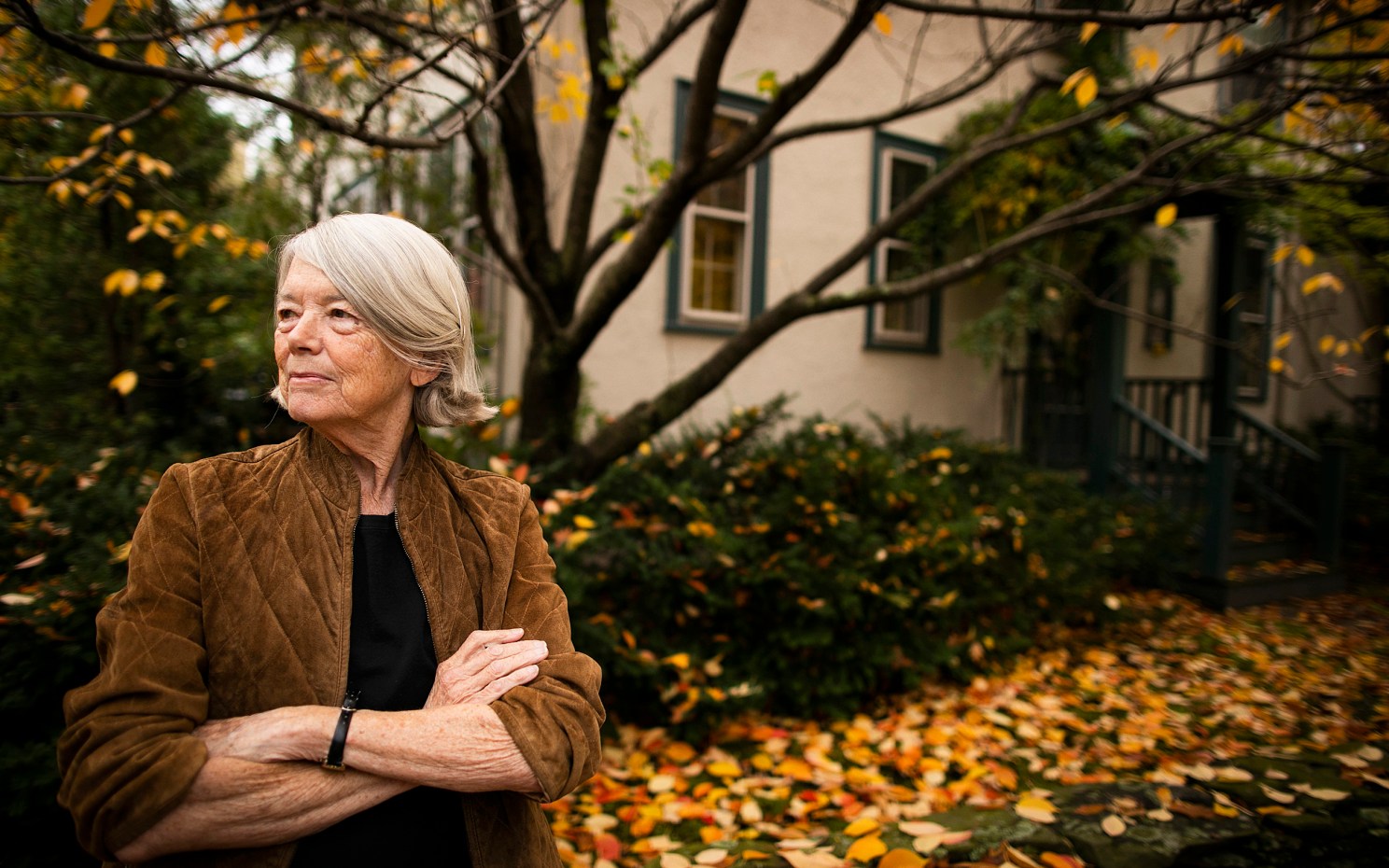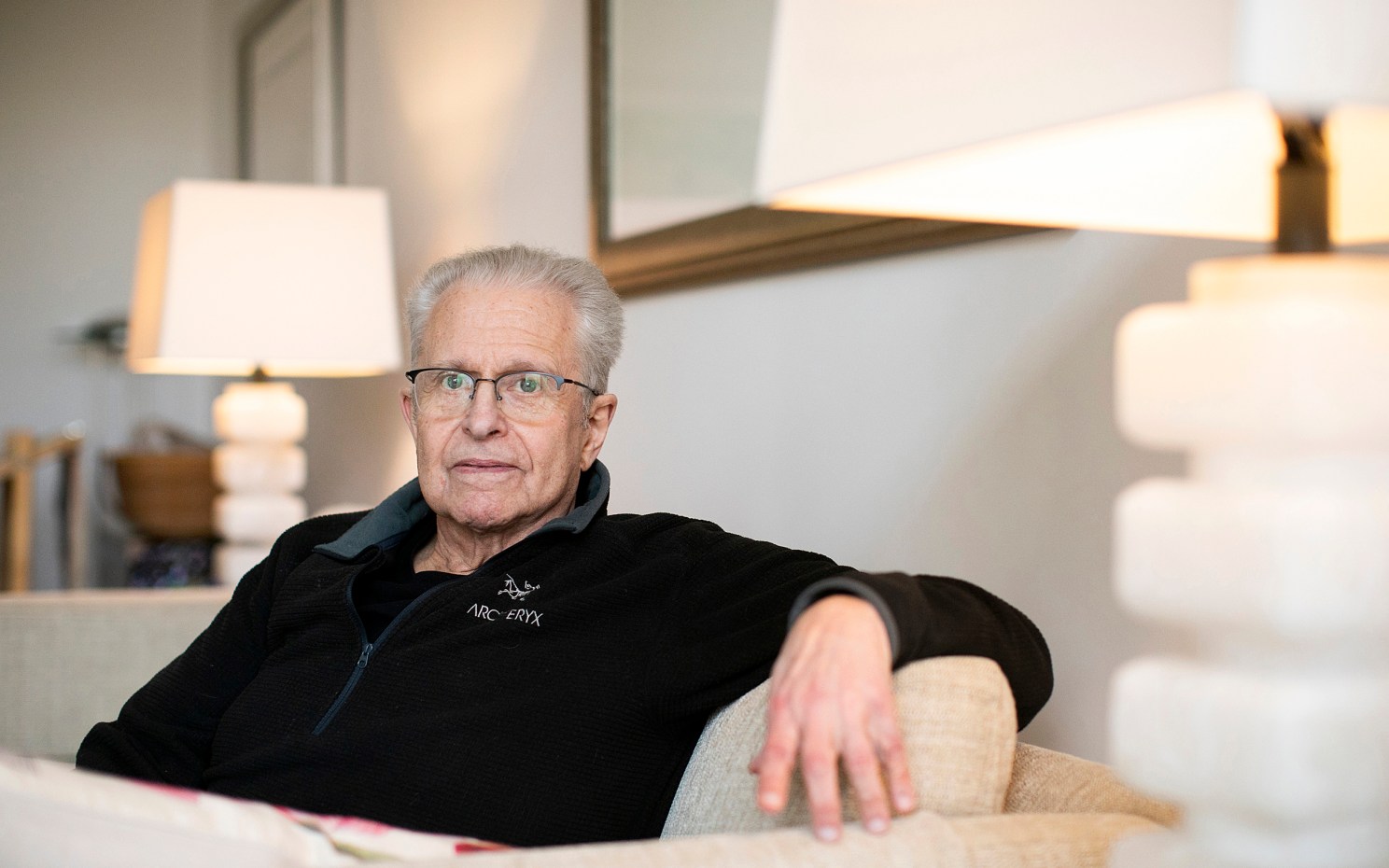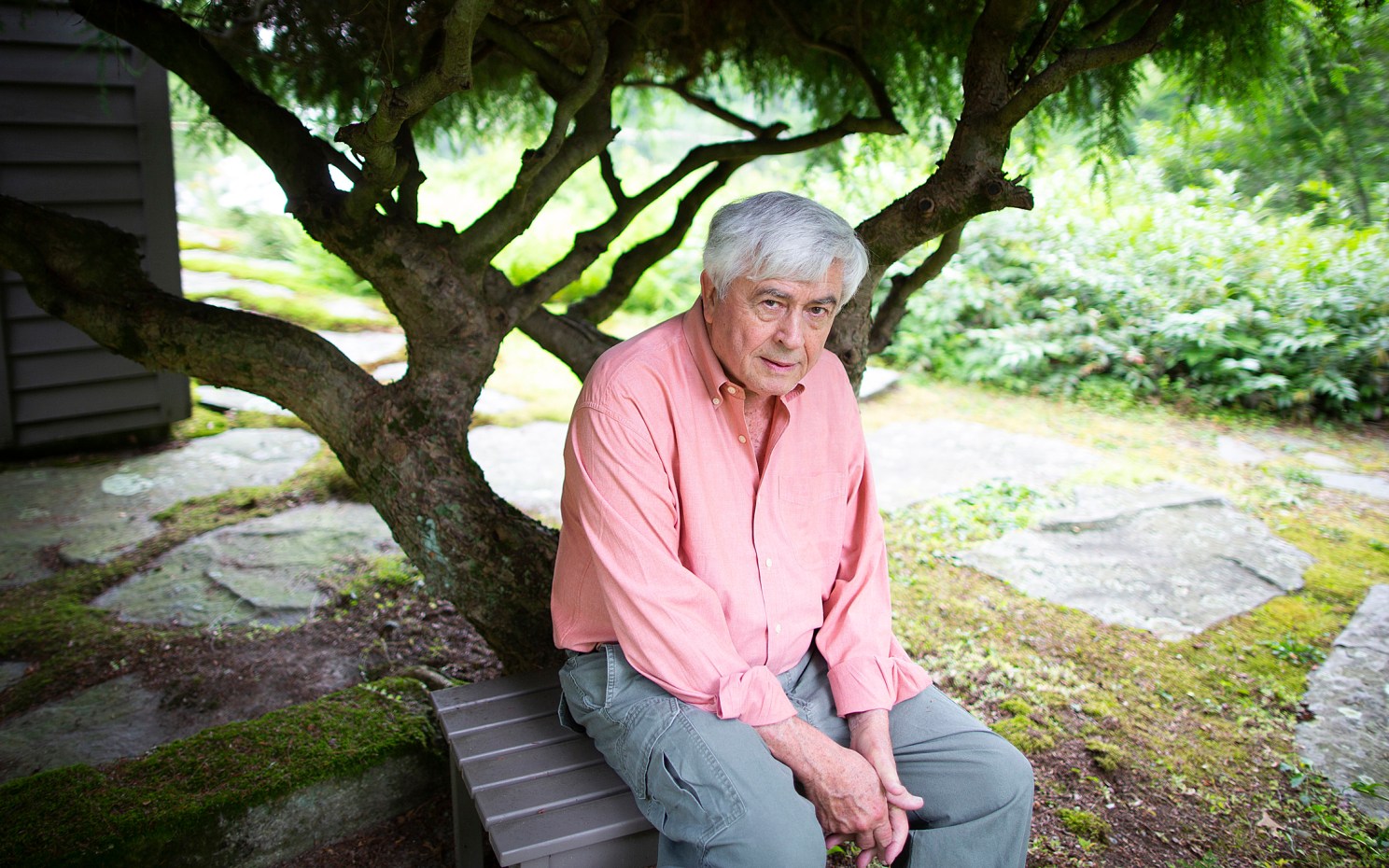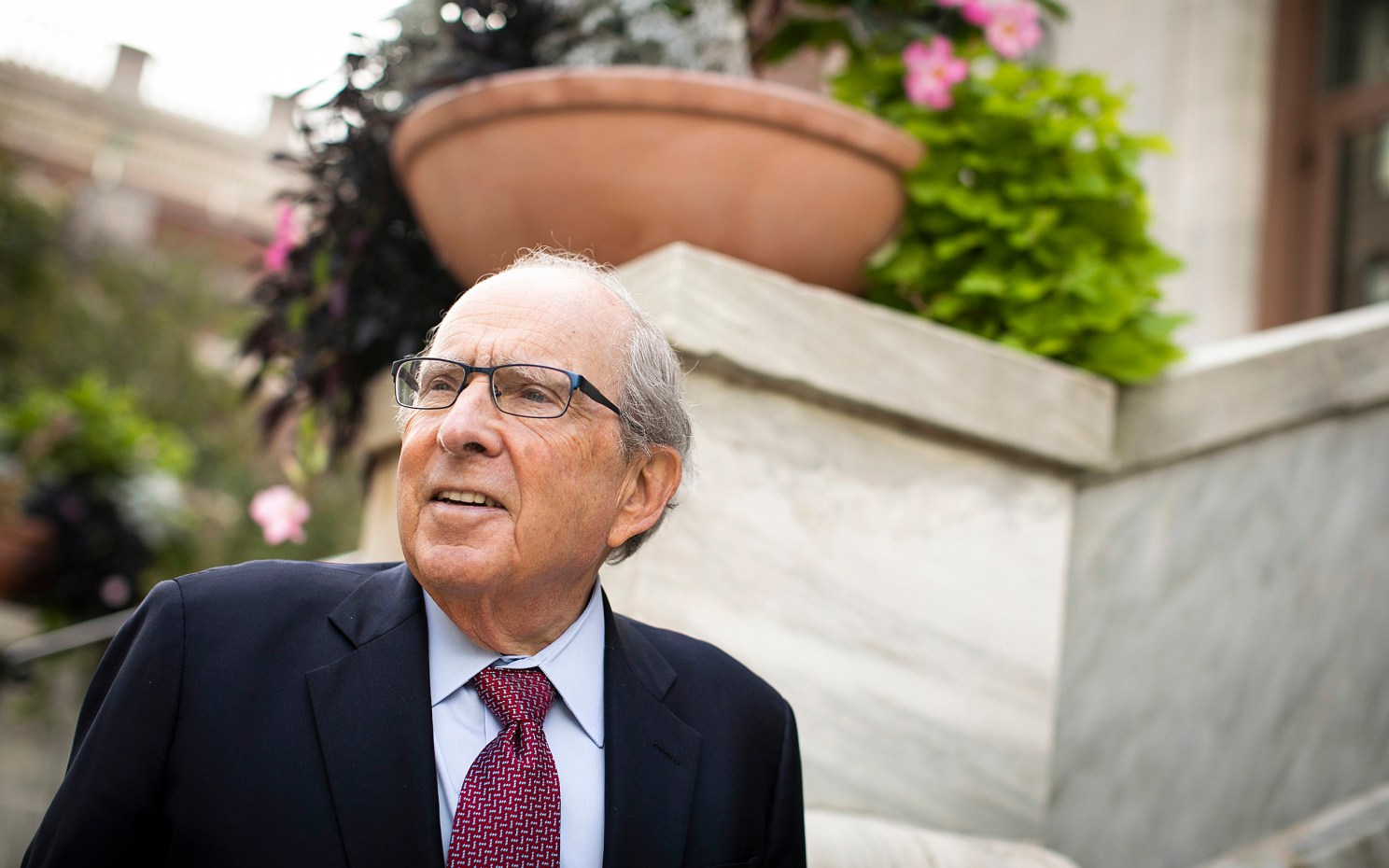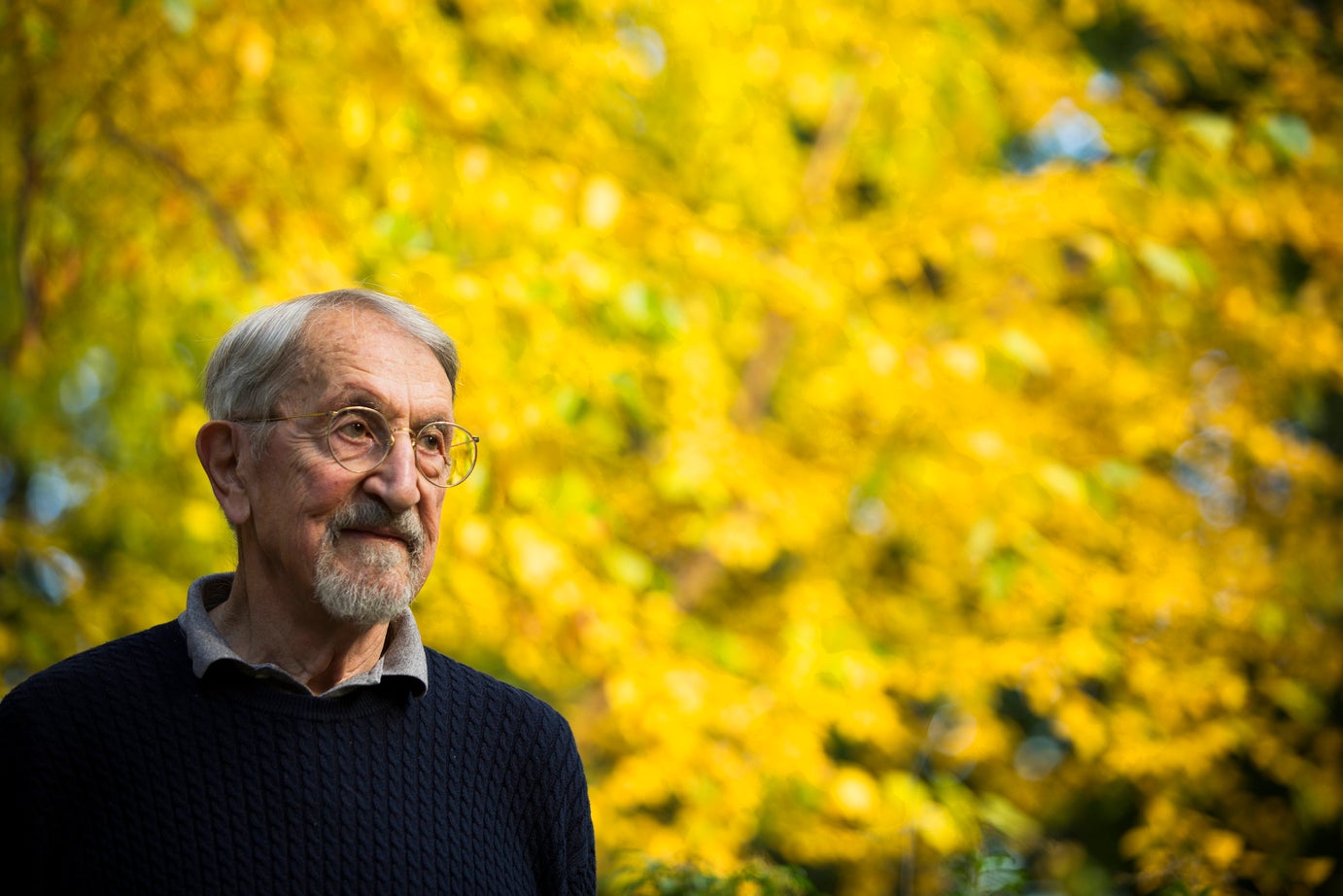
Photos by Stephanie Mitchell/Harvard Staff Photographer
‘I had the conviction that my ideas were correct’
In America, safe from Nazi power, Martin Karplus began on a Nobel Prize journey quickened by intuition
Part of the Experience series
Scholars at Harvard tell their stories in the Experience series.
Martin Karplus ’51 is Harvard’s Theodore William Richards Professor of Chemistry, Emeritus. In 2013 he shared the Nobel Prize in chemistry with two colleagues. He maintains that the only real chemistry he does is in the kitchen.
Karplus, 87, is at work on a memoir. The book will tell a story that moves from a sunny boyhood in Vienna (he was born in 1930, the scion of an accomplished Jewish family), through the dark woods of the Nazi era (in 1938, the Karplus family fled Hitler’s Europe, and wound up in suburban Boston), and then into the sun again, when Karplus discovered science in earnest. He published his first academic paper at age 17; earned early recognition at the California Institute of Technology as a protégé of two-time Nobel laureate Linus Pauling, who called him “my most brilliant student”; and started his Harvard teaching career in 1966.
When the Nobel arrived, an admiring world found this father of three grown children in a bower-hidden house on Irving Street in Cambridge. He and his wife, Marci, and their dog Bib travel the globe, and summer at their chalet in France. But on most days, Karplus is at home on Irving Street, doing his intent theoretical work at a laptop in the dining room, with Bib dozing at his feet.
Let’s start with the day you won the Nobel Prize, a moment many dream of and few see.
It was 5:30 a.m. on October 9, 2013. My wife was awakened by the telephone next to her side of the bed. Still half-asleep, she woke me to say that the phone call was for me. My initial reaction was that if someone was telephoning at 5:30 a.m., it was an emergency involving one of my children. When I got out of bed to answer the phone, I expected the worst.
The voice on the phone said, “This is Stockholm calling. Is this Professor Karplus?” I said yes and someone — I later learned it was Gunnar Karlström, chairman of the Nobel committee for chemistry — congratulated me on winning the 2013 Nobel Prize in chemistry. The other members of the committee then congratulated me in turn. It was only when Astrid Gräslund, the secretary of the committee, who I knew from her work in biophysics, repeated the congratulations that I finally believed that I had actually won the Nobel Prize, the highest recompense for scientific achievement.
Then came weeks of intense attention. When did life return to normal?
It never did, in a way. E.J. Corey, who received the chemistry Nobel Prize in 1990, when he was 62 years old, remarked at a reception for me held in the Chemistry Library that I was lucky to have received the prize when I was 83 years old because it gave me over 20 more years to do research without being called on to do other things.
I received, and continue to receive, invitations to go to conferences, most of which I refuse because it is clear that all they want is my name, rather than my knowledge. However, there are invitations that I do accept. Primarily, they involve occasions where I can reach out to young people and try to inspire them to go on with their education by exposing them to the excitement of making discoveries. Getting a Nobel gives you a pulpit and new opportunities to make a difference in the world.
You came from an accomplished, prosperous family.
Both my grandparents were from families that had scientific achievements and interests. My maternal grandparents came to Vienna in the early 1900s. My grandfather finished his education at the University of Vienna. My grandmother’s parents had insisted that she finish her studies, in economics, which she did before getting married in 1899.
My mother, the oldest of four siblings, was born in 1900. My grandfather went to work at a health clinic which specialized in fango, a slightly radioactive mud. After a few years, he became chief of the Fango-Heilanstalt. My grandparents had an apartment there.
My great-aunt, Eugenie (Aunt Jenia) Goldstern, an ethnologist who now is very well known, also lived in the Fango. I liked visiting there, in part because Aunt Jenia would bring toys she had collected for me to play with. She was one of the few members of the family actually murdered by the Nazis.
What about your father’s parents?
My grandmother, like many women in that period, stayed at home and ran the household. Her mother, Anna Lieben, was one of Freud’s first patients. My grandfather was a neurologist, a professor at the University of Vienna. They lived on the Ringstrasse in the Ignatz Lieben palace, right across from the main building of the University of Vienna. We used to go there on Sundays for afternoon tea with delicious Viennese pastries.
My grandfather is recognized now as discovering the function of the hypothalamus. He demonstrated that its action was based on releasing hormones, a revolutionary discovery.
The names that my grandparents chose are all normal Austrian German names. They have no Jewish connotation, in contrast to the name that we gave to our son Mischa. We were all what people called “Tannenbaum Austrians,” which means they had Christmas trees. We used to celebrate Christmas and get presents. Such holidays played an important role in my feeling of belonging.
It was expected that you would be a doctor.
It was tradition on my mother’s side that somebody in the family would be a doctor. My Aunt Lena was the doctor of her generation and I was interested in becoming a doctor when I was little. I would go around bandaging chair legs.
Both your parents studied physics, though neither took a degree. Your father especially was an early influence.
He played a very important role, not as an official scientific mentor, but as an example of what you have to do when you are faced with problems. He always took a positive viewpoint, even in describing his stay in the jail in Vienna for six months under the Nazis. He described it as a wonderful experience. He taught his jailors how to play chess and they had chess tournaments.
When we had made arrangements to leave Austria, we thought that all of us would be able to go together on this “excursion” to Switzerland in March 1938, shortly after Hitler came in. But it turned out that only my mother, my brother, and I were allowed to go.
After he had signed all our possessions over to the Nazis and paid a “release tax,” he joined us in Le Havre [in France] and we came together to the United States in this miraculous way. An uncle in America helped pay for his release.
That’s what he and my mother transmitted to me and my brother [the late Robert Karplus, three years older, who finished Harvard College in two years and by age 21 was a Harvard Ph.D. in physics]. Obviously my parents didn’t know whether he would get out of jail. They didn’t know that he would be able to come with us to the United States, but the way it was described it was so positive that I never worried.
You grew up in a supportive, loving world when you were a child. Then the world changed.
Austria later tried to say that it was the first victim of Nazism, but they were much more anti-Semitic than the Germans in many ways and they invited Hitler in. Of course, the government had changed and a Nazi had been put into power in Germany before [Anschluss on March 12, 1938]. It was three days before my birthday and my parents and some friends were listening to the radio. The windows were blacked out. Some planes flew overhead when Hitler came in. I remember that vividly, not because I was really aware of the political situation but because it was my birthday. I was very annoyed that my parents weren’t at all interested in celebrating. We did have a cake, but basically it was clear that I was a secondary person, unlike what happened in previous birthdays.
You would summer on lakes in Austria, or on the Adriatic.
There was this incident on the Adriatic when I was 5. Some relative I did not know picked me up. I did not like being treated like a baby. I told her, “I’m a Nazi.” I somehow already was aware that it was about the worst thing I could say. She did actually drop me.
Then 1938, and real Nazis arrived.
We were lucky to be able to escape. But before that, my history up to being 8 years old was that of being part of a large extended family. This very strong feeling of belonging and support was very important in being able to start anew in America. I had this feeling that even though my early life had been destroyed, I still had this supportive background.
You have written that being a refugee, having to leave suddenly, in a way inspired you in terms of the kind of science you do, because you have no fear to leave something behind and take up something new.
If I had stayed in Vienna, if there hadn’t been Hitler, probably I would’ve gone to the University of Vienna and been a reasonable scientist. But I wouldn’t have had quite the push to do something special that was given to me by having to leave Austria and immigrate to the United States.
[The family settled in Boston, and soon after in Newton. Karplus described the microscope his father gave him when he was 9, and the hours he spent observing rotifers and other microscopic creatures. It awakened a lifelong interest in biology.]
My brother was three years ahead of me in high school and had an outstanding record. Actually I had an outstanding record, as well. In high school, I got all A’s except for a chemistry course. I got a B from the chemistry teacher who [when Karplus wanted to apply for the Westinghouse Science Talent Search] said, contrasting me with my brother, “With you, it’ll be a waste of time.”
In spite of that I went ahead. I did become one of the 40 finalists who went to Washington and met President Truman. In those days, the top prize was given to one boy and one girl, and I was one of the two top winners. That played an important role in my life. I remember that one of the people important to me, who urged me to apply, was my brother. So in spite of a competitive relationship on the one hand, it was clear that he felt that I was doing things that were worthwhile. That other people had faith in me and my work was very important.
“It was important to me that I was able to organize my life so there were parts of it that had nothing to do with science.”
What led to Harvard College?
My best friend in high school, Alan MacAdam, had seen a notice about the Lowell lectures on birds, by Ludlow Griscom, the curator of ornithology at Harvard. I had not heard of him at that time, and thought it would be interesting to attend.
I was really fascinated by his description of how you could identify birds by field marks and be able to go out in the woods and study them. As it turned out, Alan wasn’t that interested, so he didn’t accompany me after the first lecture, but I continued to go there. It was in the middle of the winter and I still remember the back rows of people just sitting there bundled up. I’m sure they were just trying to keep warm. They were not interested in the lectures, but for me it was an eye-opener.
After several of the lectures, Griscom came up to me and asked who I was. I guess he was surprised that this young person — I was in high school, so I must have been about 15 — was interested in the lectures. He invited me to go on some field trips with him and other birders.
When I was already at Harvard, I went to the Patuxent Research Refuge as a summer intern. There I did a project on looking at two areas, one that had been subjected to DDT and the other that had not. I described how there were fewer young and the egg shells broke more easily in the DDT plot. This research project increased my interest in biology and in research. Until I went to Harvard, though, I still had had the idea that I would be a doctor rather than being some sort of scientific researcher.
At Harvard, I took a chemistry course from Leonard Nash, who played a very important role in my life. He was a superb teacher, although the course was fairly elementary for me. After class he would meet with us — we were a group of friends all living in Adams House. I had decided to live there because it had the best food at Harvard. Nash would talk about things beyond what were actually in the course. It was at that point that I concluded I would rather try to understand what was going on in biology and the biology of people than become a doctor.
I had the foresight that to really understand biology, you had to learn about chemistry and physics, because to understand biological phenomena you needed to understand their chemical origins. So I went into a special program of chemistry and physics that existed at that time only at Harvard. The program was very flexible in terms of what you had to take and what you could take. One of the very good attributes of being a Harvard undergraduate is that you could go into any course you wanted; if you failed it was your problem. So I took a number of biology courses. One of them was a course taught by George Wald, who was later a Nobel Prize winner. He was another one of the mentors who played an important role in exciting my interest in biology and in making me realize that chemistry and physics could be used to understand biological phenomena.
Wald and Nash were influences at Harvard. Who else?
I had met Professor Robert Galambos, who was working downstairs in Memorial Hall. He had a lab there. He discovered the bat echolocation phenomenon in collaboration with Donald Griffin, a professor of ornithology at Cornell. He got me to contact Griffin, who invited me to spend the summer with him at Point Barrow, the northernmost point of Alaska, where there was a naval research laboratory where we could stay. I was 17 years old at the time.
I did publish a paper in 1947. I organized my co-workers — all much older than I was — to study robins, which nest there. I looked recently and saw that the paper was still being cited. There are so many serendipitous events in my life which played an important role.
You were just out of Harvard when you met Einstein. I have to ask you about that.
It was a complete accident. I was visiting my brother, who was at the Institute for Advanced Study. I met Robert Oppenheimer, who was his adviser. I had decided I wanted to go to the West Coast and had been admitted to Berkeley and Caltech. It was very hard to decide between them. So I asked Oppenheimer what he thought. He had been simultaneously a professor at both institutions. He recommended Caltech. As he described it, it was “a shining light in a sea of darkness,” meaning that at that time, in Pasadena, there was nothing much to do. Then Einstein came in and my brother introduced me. He said something nice with a strong accent and then went on.
How did he strike you physically?
He had a big head of hair, that’s what you notice. Even though he’s not that big, you get the feeling of a big person.
You started at Caltech in 1950.
When I went to Caltech, I started as a graduate student in biology rather than in chemistry. I thought that Max Delbrück, who had been a physicist and had put phage genetics on a scientific basis, would be just the right person with whom to work. As it turned out, that was a disaster.
This was a seminar in your first year. A formative moment because it cast you out of biology and back into chemistry. What happened?
Delbrück, when people wanted to join his group, asked them to give a seminar, and having worked on vision, I talked about the chemistry of vision. Delbrück did not know very much about chemistry and also, like many physicists, looked down on chemistry. I started to give my seminar, and after a couple of minutes, he yelled out from the back of the room, “I don’t understand what you’re saying!” — obviously implying that I was not being clear and that I should repeat. We went through this several times, my not getting beyond my introduction, over about 20 minutes. As a graduate student who had just arrived, I was getting terribly nervous and terribly upset. Richard Feynman was there. I was taking one of his courses on quantum mechanics and knew he was interested in biology — he was interested in everything — so I had invited him to the seminar. Feynman was also sitting in the back, maybe three or four chairs removed from Delbrück. So at one point when Delbrück said, “I can’t understand what you’re saying,” he whispered in a way that everybody could hear, “I can understand what he’s saying, Max.” At that point, Delbrück got red in the face and rushed out of the room. He asked me to come over and see him as he left. I went to see him, and he said, “Look, you can’t work with me.”
That seminar changed your life.
Absolutely. I went back to chemistry, went home, as I said, having had this shock. When I returned to chemistry, I started working for John G. Kirkwood. He was doing studies of electrostatic effects in biomolecules by statistical mechanics, and so it seemed like a natural thing to do. Then in the spring of 1951 he accepted an offer to go to Yale. I decided to stay at Caltech and work with Linus Pauling, which I think was the right decision. I had read “The Nature of the Chemical Bond” when I was an undergraduate at Harvard. It gave me the insight that chemistry could be understood using quantum mechanics, that there was a logic in chemistry.
So I really liked being at Caltech. It was a very social environment. We used to, groups of us, go camping in the desert and have parties in our Altadena house, where sometimes Feynman would come and play the drums. So I just felt I wanted to stay. It was partly Pauling and it was partly the whole environment there.
What was it about Pauling?
Pauling was very interested in hydrogen bonding and of course that plays a very important role in the structure of the alpha helix, which he worked out, as the story goes, when he was sick in bed and had some strips of paper and used to wind them around and realized that if you formed an alpha helix rather than another kind of helix, that the groups would be situated so that they could form hydrogen bonds all along the helix, and would give a very stable structure. I said I would really like to look at a very simple system that was biologically relevant and work out the details of where the binding energy of the hydrogen bond comes from. I chose the bifluoride ion.
One time when I asked him about a certain hydrogen bond — I don’t remember what it was — and whether the hydrogen bond would be symmetric, as it was in this very simple system that I was studying, he leaned back in his chair in a very characteristic pose, and looked at the ceiling, and then he said, “Well, it would be like . . . ” — I don’t remember exactly what he said. So I asked him, “Why do you think so?” So he thought again a little bit and told me why he thought it was. Of course I said thank you — I think we already called him Linus at the time — and left his office and thought about his explanation and realized that it didn’t make any sense.
So, the next day I went in and said, well, this doesn’t really make any sense. He agreed and then leaned back. I thought he would say his conclusion was wrong, but really the bond would be like this, but he actually, after thinking about it, looking at the ceiling and everything, again came up with a new explanation. But the conclusion was just the same. This time I asked my friends about it and it still didn’t make any sense.
Then I went in once more and as soon as I explained it to him, he agreed that it didn’t make any sense and then again came up with an explanation. This time I looked at it, and it made good sense. I did some simple calculations, which showed actually that it was correct. It made me realize — which was a very important thing — that you should believe your intuition. You should also check it, but you should believe in it — and that having ideas that go beyond what you really can prove at that time in detail is very important.
I think this has played a role in many of the things that I’ve worked on. Where other people might have said it doesn’t make any sense or whatever, I had the conviction that my ideas were correct. With Feynman, it was the same. He believed in his intuition and that that was a much more efficient way of proceeding.
Pauling also shared his view with me that knowledge of structure was the key to understanding chemical reactions. And that initial insights are often borne out by data afterwards. His ideas greatly influenced me.
You finished your Ph.D. quickly, in two years. What did you work on?
I developed a method for treating the bifluoride ion, the Pauling problem I worked on, in which there are contributions with the electrons differently distributed. Calculating the energy of these different contributions accurately was not possible using the quantum mechanics that was accessible with the punch card computers that were available. So I developed a way of introducing empirical data about atomic structure to correct for errors in the calculation.
I had this great theory and applied it to this molecule. As I was getting to the end of my thesis, Bill Moffitt, a professor at Harvard, invented a method called Atoms in Molecules, which was very similar to what I had done. It was more general in some sense, and more beautifully worked out, but my ideas were very much the same.
Pauling’s friend and colleague Verner Schomaker called this my “great idea.” I felt so disappointed that I never wrote up my thesis. It’s never been published.
After Caltech came Oxford and two years as a National Science Foundation fellow. You arrived in England shortly before Christmas in 1953, and left almost immediately for your first trip to Paris.
I had been given a Leica by my parents as a Ph.D. present and I traveled a lot. I’d be in residence during three six-week terms. For the weeks between, I’d travel. I was 23 years old. I had my Ph.D. and I felt I wanted to do other things in addition to science. My Harvard and Westinghouse friend Gary Felsenfeld came to Oxford after a year and together we bought a Volkswagen, a little green Beetle, which appears in some of my photographs. We used that to travel all over Europe, each time taking a different route. During those trips, I started trying to record the lives of people that I thought in 10 years or so would’ve changed, partly by war or by radio and television. They were becoming homogenized, and I wanted to record what life was like before then.
Has photography influenced your sense of doing science at all?
No, I think they are separate. I think there is an overall theme of understanding the world and trying to record what is known and finding new relationships.
Food is another passion beyond science, running like a thread through your whole life. Where do you think that comes from?
It really begins with my mother, who was a dietitian in Vienna and worked at my grandfather’s hospital, the Fango. When we visited relatives, there were always wonderful pastry dishes. Many people say, “Well, cooking is chemistry anyways,” but I’ve not thought about it. They are completely separate in my mind. It is only in very recent years that I became somewhat interested in that, particularly from working in the kitchen of El Bulli, the famed Spanish restaurant where Ferran Adrià introduced what is now called molecular gastronomy.
At Oxford, you joined Charles Coulson’s group in theoretical chemistry. But wasn’t it Oxford that gave you the sense that studying chemistry had to have some kinds of utility?
My feeling was that theoretical chemists just talked to each other and that the problem that Coulson gave me wasn’t really very interesting. I played with it a little bit, but I didn’t really work on it. I regarded myself as a theoretical chemist, but I felt I wanted to do something that was of importance more generally in chemistry and physics. At Oxford, there was a physics professor, M.H.L. Pryce, who gave a course on magnetic resonance. I had the intuition that nuclear magnetic resonance in particular was a field where if you worked on theory in that area, it could be really useful in chemistry. But I spent more time thinking about problems in chemistry than actually solving them.
Magnetic resonance as a way to work on chemical problems led you to the University of Illinois, where your work on molecular dynamics really began.
Illinois seemed like a great place to go. Serendipity played a part. Because a number of people had retired in the department, they were looking for young people to hire. So Pauling gave them my name. The next thing was that they offered me a job. I had not published a single paper in chemistry.
I had been working on a paper, which was a very simple paper, but it already had the objective of trying to do calculations which could be checked by doing experiments. I agonized over it, wanting to make sure that I didn’t make any mistake, because I had to do all these calculations by hand on a desk computing machine.
I accepted the job offer without visiting the department — something unimaginable today, when getting a job involves such extended courtships. After such a good time traveling in Europe, I thought Urbana-Champaign seemed like a place I could concentrate on science with few distractions.
What did you work on at Illinois?
I was interested in applying theory to chemically interesting problems. I realized that one could measure couplings by NMR, interactions between two hydrogen atoms in a molecule in which they weren’t bonded together. The coupling didn’t have to be very strong, but there was a measurable effect. So I started to look at this by taking a very simple six-electron system of hydrogen, carbon, carbon, hydrogen as a model for ethane, for which there were detailed experimental measurements.
I used valence bond theory, which was developed by Pauling to a great extent, and worked out a model that used some empirical data about the interaction constants, to determine the angular dependence of the measurable coupling constant. The model system had to be simple because there weren’t all these big computers. Even the simplest calculations took a great deal of effort.
A group of young professors that had been hired in Illinois at the time used to go out to dinner at a Chinese restaurant and talk about what interesting things we had found. I told one of them, E.J. Corey, about my idea. He immediately realized that it could be useful in organic structure determinations. He published the first paper which used it.
Then other organic chemists realized its importance, but like many people who used these theoretical ideas, they didn’t bother to read in detail what I had written about its limitations. So people used what came to be called the Karplus equation for structure determinations. They found that where they could determine the structure independently, the results didn’t agree exactly. I wrote about the limitations of the theory — defending myself, if you like — and then ended the communication with the statement that anyone who tries to use this theory to determine the angular dependence to a high degree of accuracy does so at his own peril.
The equation is still widely used. It has taken on a life of its own and I’m very happy with it. I was known to more people from the Karplus equation, because almost every elementary chemistry course included it, than actually for the molecular dynamics work, which contributed to my Nobel Prize.
Could you say more about the nature of that molecular dynamics work?
The essential realization leading to the Nobel Prize was that even for very light atoms, you could use classical mechanics to describe their motion, just like you calculate the motion of billiard balls, by solving Newton’s equations. This worked for the exchange reaction of H with H2. Given that classical mechanics could be used to describe the motion of these, the lightest atom for which quantum mechanics is expected to be most important, it should be applicable to heavier atoms, like carbon, nitrogen, and oxygen, of which proteins and nucleic acids are mainly composed.
It’s a very simple idea, but we showed that it worked for the H+H2 reaction. We tried it and we got results that agreed with experiments qualitatively, because the experiments weren’t that detailed at the time. It was only 10 years later when Aron Kuppermann, who was a good friend of mine, and Bob Wyatt were able to do a full quantum mechanical calculation for this reaction and show that our results, in fact, were very accurate.
We then started looking at the internal dynamics of small proteins. It was again one of these areas where people really didn’t think that one could do it. In a certain sense, going from H+H2 to a protein molecule is conceptually not that different. You need a potential energy surface on which the atoms move. Once you know the potential energy as a function of position, you can calculate the forces on the atom, and then from the forces on the atom you can integrate Newton’s classical equation of motion to find their positions as a function of time.
Whether you do it for three atoms or for 1,500 atoms, conceptually it’s the same idea. One just needs some way of obtaining the potential function and then you solve Newton’s equation step by step. I had to believe that it would really be useful and go ahead and do it. Of course history has shown that it is. There are now thousands of people doing molecular dynamics calculations and applying them to many different problems. In understanding biological phenomena and in drug design and other areas, they’re very important.
The idea of being able to study the dynamics of H+H2 — chemical reaction dynamics — began at Illinois. But it was only at Columbia that I had the computing power, by working at the IBM Watson Scientific Laboratory, to carry out the calculations.
You started at Columbia in the fall of 1960.
Yes. The Watson Lab had an IBM 650, an early digital computer, and I had access to considerable amounts of time on it, and support for postdocs. My interest in chemical reaction dynamics deepened at Illinois but I started the real research only once I got to Columbia. Access to computational power made it possible to calculate the molecular reactions at a fundamental level. For the H+H2 reaction, I was able to compare with experiments on the effect of temperature on the rate of the reaction, as well as new molecular beam studies of reactive collision. In all, the work provided insights concerning the fundamental nature of simple chemical reactions that are as valid today as they were 40 years ago. One paper, from 1965, on the quasiclassical trajectory method we developed, has been called one of the key papers in 20th-century theoretical chemistry. Unlike quantum dynamics calculations, the method was easily extended to other systems.
I had the philosophy that I should change the school where I worked every five years. I worked at Illinois for five years and then went to Columbia for five years, when I decided I wanted to move again. At that time I was pretty well known as an outstanding young theorist and so got offers from about 20 different schools, including Caltech, Chicago, Berkeley, and Harvard.
You felt the pull of both East and West.
I tried to narrow down the schools to consider. Finally it was Berkeley versus Harvard in my mind. To help me decide, I spent six months at Berkeley. Berkeley seemed to me too nice a place. People weren’t serious enough there, and they didn’t really believe in theoreticians very much. I decided I would go back to Harvard. Of course it was home in some sense. And E.J. Corey, who was the chairman at the time, thought I could replace Bill Moffitt, who had died young, as their theoretician.
Where you were an undergraduate, to be on the faculty is something so special. The faculty was very interesting to me, and of course the best thing about Harvard is the students — both undergraduate and graduate students. After a few years I also returned to my long-standing interest in biology, which was also like coming home. My research work in theoretical chemistry had been busy and successful, but if I was ever going to make a break it had to be soon. I had grasped what was going on in elementary chemical reactions, and the excitement of learning something new was no longer there. People with different skills than mine were better able to contribute to this field.
You took a six-month leave in Israel to explore ways you could apply theoretical chemistry to biology.
The Weizmann Institute had an excellent library, which I thought would be helpful. Shneior Lifson invited me to join his group on polymer theory. Discussions with him and visitors helped me explore how to make a change. It was there I was first challenged by the mechanism of protein folding, which has been an interest ever since.
Around the same time, in another instance of serendipity, I read a paper on the chemistry of vision by Ruth Hubbard and George Wald in a volume dedicated to Pauling, “Structural Chemistry and Molecular Biology.” I had studied with Hubbard and Wald as an undergraduate, but it occurred to me that the understanding of retinal — the key chemical in vision — had not advanced much in 20 years. Here was a biologically interesting system to work on, to use theory to predict the structure of retinal and its photoactive isomer.
I also began to work on hemoglobin. With Attila Szabo, I developed a statistical mechanical model of hemoglobin that transports oxygen in the blood from the lungs to the tissues. I wrote most of the resulting paper in 1972 in Paris at Les Deux Magots, a Left Bank cafe associated with artists and intellectuals, from Hemingway to Sartre. I was on sabbatical leave in Paris, and since 1970 had been planning a permanent life in France. My canonical five years were up at Harvard in 1971.
Why not move?
It was just administratively too complex to work in France at the time. For one, foreign professors couldn’t get permanent jobs. Professor were fonctionnaires and one had to be a French citizen to be a fonctionnaire. I was not willing to give up tenure at Harvard if I didn’t get a permanent job in Paris.
So no regrets about coming back to Harvard? It would’ve been in 1973.
Yes, regrets that my dream of working in France had not worked out. But around this time we started spending summer vacations in the foothills of the Alps above Annecy. We finally bought a plot of land in 1974 in Chalmont, a small hamlet near there, and built a chalet.
You work there in a different way.
When I’m working, I work all the time and then I decide to not work for a while and do other things. To have such separate parts in my life has played an important role in keeping me young and active.
We used to stay at the chalet for six weeks or two months in the summer. Once we were on the plane, a different life began. While we were there we would talk with the local farmers about how their cows were doing, where to find the best local cheese, and so on. This decompression played an important role in my life. However, I didn’t really stop thinking about science. But it was in an entirely different way. There were a number of cases where I found solutions to problems while on a hike that I hadn’t been able to figure out when I was in Cambridge. Having this relaxed interlude was essential.
It was important to me that I was able to organize my life so there were parts of it that had nothing to do with science. That is different from most of my colleagues, who basically don’t have other things that they do, and who also, I think, were disturbed by the fact — that’s probably the only way to describe it — that I would go off for two months just to live in the countryside somewhere, to go hiking and swimming. It didn’t make sense to them that I could do this and still be able to do what turned out to be outstanding science.
It was good to be back at Harvard. For one, I was back to finding ways to combine theoretical chemistry with biology.
Your work on protein folding, for instance.
That interest started at the Weizmann in 1969. At Harvard we used molecular dynamics simulations to elucidate the mechanism, which was once a rather esoteric subject, but is now of central importance. For one, protein misfolding during transcription has been suggested as a likely cause of some human diseases such as Alzheimer’s. In 1975, David Weaver and I developed a diffusion-collision model of protein folding, and I increasingly worked on understanding biological macromolecules like proteins.
Combining theoretical chemistry with biology has made you a version of that doctor your grandparents dreamed you would be. But you work on the molecular dynamics behind big biological questions — oxygen transport in blood, the chemistry of vision, how proteins fold. Could you talk about the biology-related work you are doing today?
Some postdocs and I are part of a project on the adaptive immune response led by Arup Chakraborty at MIT. The focus is on the human immune response to HIV. What if there were a vaccine someday that conferred a broad-based immunity that keeps ahead of HIV mutations? More generally, for any virus, such as the flu virus, is there a way to confer permanent immunity? It’s a problem in immunology that requires understanding how the immune system really works to find ways to generate antibodies that bind more strongly to the virus, but not so strongly that the antibodies are highly specific.
Doing good in the world has also taken on a political dimension for you, from protests in your graduate student days over the death sentences meted out to Julius and Ethel Rosenberg to speaking out, after your Nobel, about anti-Semitism evident in modern-day Austria.
After years of trying, I finally managed to gain access to my FBI file after winning the Nobel, when one of President Obama’s legal team interceded for me. It is 300 pages long. It’s a very big file, and contains so much information about my life that it almost could be used for my biography.
But your life has been full of serendipity, as you say, and charmed and lucky.
We used to walk around a lot when we were living in Paris. There was a bum that I would meet regularly on Rue Monsieur-le-Prince. He was begging. I think of myself: If it weren’t for all these serendipitous accidents, where would I have ended up? I was lucky enough to have come out where I am.



